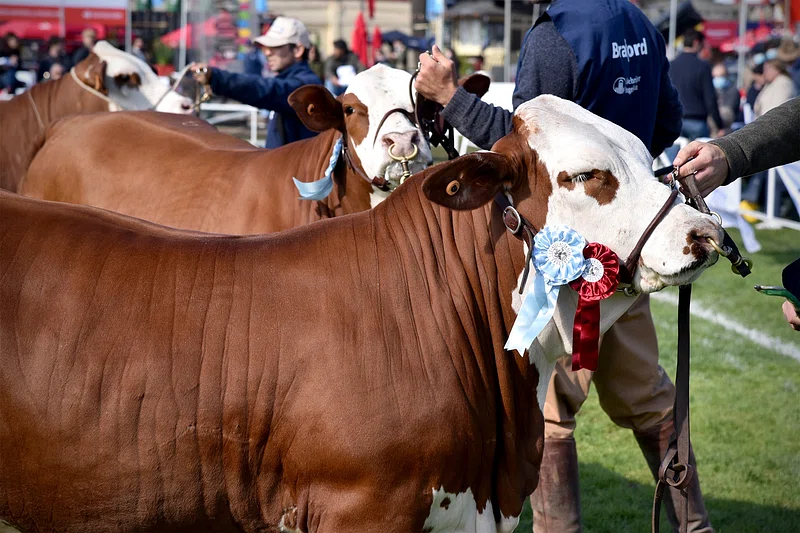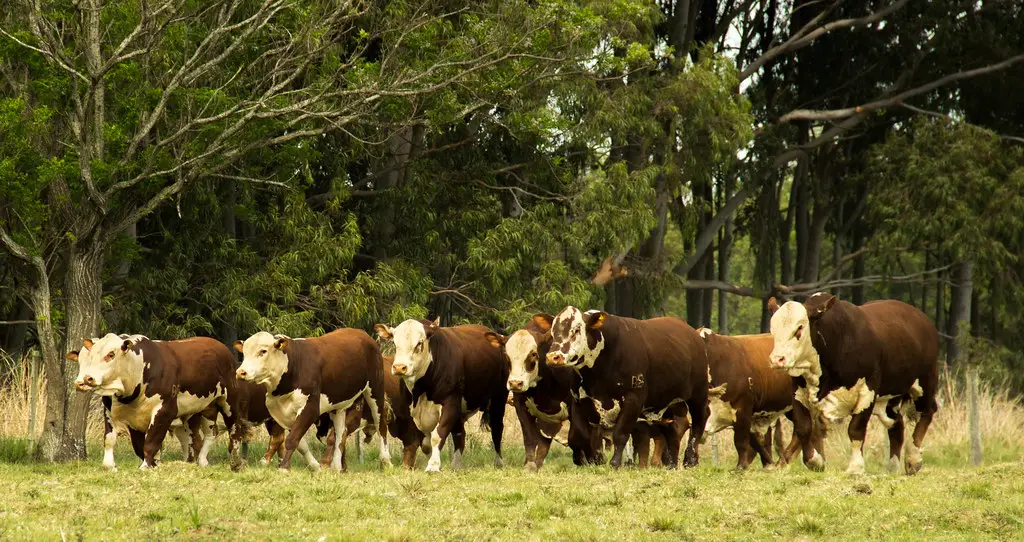
Braford Cattle! Whether you’re a seasoned rancher or just starting out, choosing the right cattle breed is crucial. You want animals that thrive in your climate, produce top-quality beef, and are easy to manage. If you haven’t considered Braford cattle before, it’s time for a closer look. This remarkable breed offers a compelling mix of hardiness, maternal instincts, and delicious beef that could be just what your operation needs. Let’s dive in!
Origin
Brafords have a fascinating history. They were developed in the United States during the 1940s to address the challenges of raising cattle in hot, humid climates. Ranchers in Florida crossed Hereford cattle, known for their superior beef quality, with Brahman cattle, renowned for their heat tolerance and insect resistance. The result was the Braford breed – a perfect blend of the best traits from both parent breeds.
Characteristics
Brafords are easy to spot. They typically sport a red coat with white markings on their underbelly, head, and feet, resembling their Hereford lineage. They also have a slight hump, a nod to their Brahman ancestry. Here’s what sets them apart:
- Built for the Heat: Brafords handle heat and humidity like champs, making them a great choice for southern regions or places with harsh summers.
- Natural Resilience: They have superior insect resistance, reducing the need for frequent pest control.
- Mothering Experts: Braford cows are known for their excellent calving ease, strong maternal instincts, and ample milk production.
- Tasty Beef: Brafords inherit the renowned beef quality of Herefords, producing flavorful and well-marbled meat.

Pros
Let’s break down the benefits of raising Braford cattle:
- Adaptability: They flourish in tough environments where many other breeds struggle. From the heat of the South to the tropical climates of Central America, Brafords take it in stride.
- Excellent Mothers: Worry less about calving difficulties and enjoy healthier calves thanks to Braford cows’ mothering prowess.
- Delicious Beef = Happy Customers: Braford meat consistently gets rave reviews, ensuring strong demand from consumers.
- Low Maintenance: Their hardiness and natural resilience translate to fewer veterinary interventions and lower costs for you.
Cons
It’s important to consider potential drawbacks before making any decision. Here’s what you need to keep in mind with Brafords:
- Temperament: While generally docile, their Brahman influence can lead to a slightly more independent streak compared to some purely British breeds. Proper handling and socialization are key.
- Cold Climates: While hardy, Brafords are best suited to warmer regions. If you experience extremely harsh winters, consider additional shelter or hybrid breeds with even more cold tolerance.
Characteristics Table
| Trait | Description | Notes |
|---|---|---|
| Color | Red with white markings on underbelly, head, and feet | Similar to Herefords |
| Size | Medium to large frame | Bulls larger than cows |
| Temperament | Generally docile, but can have a slightly independent streak | Brahman influence |
| Heat Tolerance | Excellent | Thrive in hot climates |
| Cold Tolerance | Good, but may need additional shelter in extreme cold | Some hardiness retained from Herefords |
| Maternal Ability | Very good | Easy calving, protective, ample milk |
| Beef Quality | High | Flavorful, well-marbled |
| Growth Rate | Moderate to fast | Reach market weight efficiently |
| Disease Resistance | Good | Reduced need for interventions |
| Horn Status | Can be horned or polled (naturally hornless) | Depends on genetics |
Braford Cows
A successful herd starts with great cows, and Brafords truly shine in this area. Their strong maternal instincts mean you’ll likely see:
- Easy Calving: Less stress and healthier calves at birth.
- Protective Mothers: Reduced predation risks due to their attentiveness.
- Ample Milk: Calves grow fast, leading to better weaning weights.
- Crossbreeding Potential: Braford cows are often used to produce “F1” hybrids with other breeds, adding their strengths to different genetic lines.
Absolutely! Let’s continue building out this blog post:
Braford Bulls
Braford bulls are the workhorses of many commercial herds. They’re valued for:
- Vigor and Longevity: Braford bulls are known for their hardiness and long breeding lifespan, bringing years of value to your operation.
- Improving Herds: They consistently pass on their desirable traits like heat tolerance, beef quality, and mothering ability to offspring.
- Crossbreeding Success: Braford bulls make excellent choices for crossbreeding programs, creating hybrid vigor and custom traits for specific markets.
When did Braford cattle come to America?
The story of Braford cattle in America began in the 1940s when breeders in Florida set out to create a breed suited to the state’s subtropical environment.
FAQ Section
Let’s wrap up with answers to some commonly asked questions about Braford cattle:
- What are Braford cattle used for? Braford cattle are primarily used for beef production. However, their athleticism and occasional streak of spiritedness make them suitable for some rodeo events as well.
- What are the disadvantages of Braford cattle? Potential disadvantages include a slightly more independent temperament than some breeds and less suitability for extreme cold weather.
- What is a F1 Braford cow? An F1 Braford is a first-generation cross between a purebred Hereford and a purebred Brahman cow. These animals offer hybrid vigor and a desirable blend of traits.
- How do you identify Braford cattle? Look for their characteristic red coat with white markings and the slight hump inherited from their Brahman ancestry.
- Do Braford cattle have horns? Braford cattle can be either horned or polled (naturally hornless) depending on their genetics.
Conclusion
If you’re looking for a breed that’s adaptable, low-maintenance, and produces great beef, Braford cattle could be an excellent fit for your operation. Their mix of Hereford and Brahman characteristics gives them a unique edge, especially in challenging climates. Consider the pros and cons we’ve discussed, and don’t hesitate to reach out to Braford breeders in your area to get a hands-on perspective!
